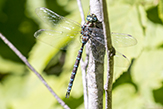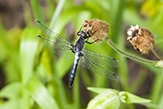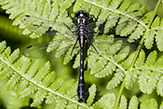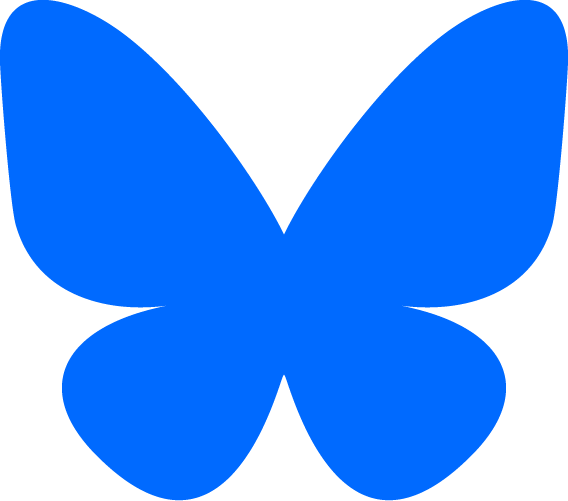Minnesota Dragonflies

Other Recent Additions
Odonata is the order of insects that is distinguished by a number of morphological features. Adults have minute antennae; extremely large eyes that fill most of the head; two pairs of transparent, membranous wings with many small veins; and a long slender abdomen. Nymphs (larval stage) have posterior tracheal gills and a prehensile labium (extendible jaws underneath the head). The order includes dragonflies and damselflies.
There are about 6,000 Odonata species in about 600 genera in 29 families worldwide. In North America there are 462 species in 90 genera in 12 families. Odonata Central lists 151 Odonata species in Minnesota.
Until recently, the order Odonata included three suborders: Anisoptera, the dragonflies; Zygoptera, the damselflies; and Anisozyoptera, morphologically intermediate between the other two. Recent research has shown the suborder Anisozyoptera is not a natural group. The suborder was abandoned in 2003 and the new suborder Epiprocta was created. Epiprocta contains two infraorders: Anisoptera, containing the dragonflies; and Epiophlebioptera, containing the former Anisozyoptera species. Epiophlebioptera contains just three living species, none of which occur in North America.
Dragonflies are similar to damselflies but are larger; the bodies are more stout; the heads are bulbous, nearly as long as wide; the compound eyes meet at the top of the head (except in clubtails); the hindwings are larger and a different shape than the forewings; the wings and are held flat and away from the body when at rest; the flight is agile, strong, and sustained; and the ovipositor, if present, is nonfunctional except in some darners.
There are about 3,016 still surviving (extant) dragonfly species in 349 genera in 12 families worldwide. In North America north of Mexico there are 330 species in 69 genera in 8 families. Odonata Central lists 109 dragonfly species in Minnesota.
It has been proposed by Rehn (2003) that the Anisoptera/Anisozygoptera group be combined into a new suborder Epiprocta. This reordering has not been universally accepted.
Recent Additions

Canada darner (Aeshna canadensis) is a large mosaic darner. It occurs across the northern United States and southern Canada. It is the most common blue darner in Minnesota, where it occurs throughout the state except for the western prairie counties. It is a late-season dragonfly, not appearing until late June and flying to the end of September.
Adults are about 2¾″ long. The body is dark brown with blue, green, or yellow markings that darken in cool temperatures. Males always have mostly blue markings. Females have three color forms; blue, green, and yellow. Most females are green form. Blue form females are rare.
There are at least ten blue darner dragonfly species found in Minnesota and they are difficult to tell apart. Canada darner is most easily distinguished by the lateral stripes on the thorax. The front stripe is deeply notched, is narrowed toward the top, and has a narrow rearward extension (flag) at the top. The rear lateral stripe is not notched. Like all mosaic dragonflies, there is a black T-shaped spot on the upper part of the face just below where the eyes meet. This is best seen when viewed from above. There is no bold black horizontal stripe across the middle of the face.

Lake darner (Aeshna eremita) is the largest mosaic darner (genus Aeshna) in North America. It is a late-season dragonfly, flying to the end of September. It is found throughout Canada, the northern United States, and the Rocky Mountains. In Minnesota it is fairly common in the northern third of the state.
The adult hunts mostly during the day but also sometimes at dusk. It is a strong flier but does not hover during flight. When hunting it cruises above the water surface with its abdomen slightly arched. It often feeds in swarms, sometimes in great numbers, often with other dragonfly species. It often perches vertically on tree trunks, rarely on the ground.
There are at least ten blue darner dragonfly species found in Minnesota and they are notoriously difficult to tell apart in the field. Lake darner is distinguished by its large size, the first lateral thoracic stripe that is deeply notched and has a dot in the notch, and a black line through the upper face.

Frosted whiteface (Leucorrhinia frigida) is a small “skimmer” dragonfly. It is fairly common in the upper Midwest, more common in the northeast. It is found from mid-May to mid-August at the edges of boggy or marshy ponds and lakes. It forages by perching on low plants at the waters edge. While the female deposits her eggs her mate will guard her by snatching and holding a rival male until the eggs are laid.
Whitefaces (genus Leucorrhinia) are identified by their white face, small black patch at the base of each wing, and black legs. Frosted whiteface males are distinguished by a brown thorax with no red markings; abdominal segments one through four covered with a whitish, waxy bloom (frosted); and the region of the wing just beyond the forewing triangle having just two rows of cells, not three. Females and juveniles are difficult to distinguish from other whitefaces.

Four-spotted skimmer (Libellula quadrimaculata) is common, widespread, and misnamed.
Eight-spotted skimmer has two large spots on each wing for a total of eight. Twelve-spotted skimmer has three large dark spots on each wing for a total of twelve. Four-spotted skimmer has two small dark spots on each wing and one large spot on each hindwing for a total of ten. A more appropriate name might be ten-spotted skimmer (Libellula decamaculata).
Four-spotted skimmer is an early season, medium-sized skimmer. It is found from mid-May to September at the edges of boggy lakes and ponds, fens, and slow streams. It is usually seen perched at the top of a tall emergent plant or a weed, often far from water.
It is easily identified up close by the two dark spots on the leading edge of each wing. It is further distinguished by the bright yellowish-brown color on the thorax and front half of the abdomen of juveniles, amber streak with yellow veins at the leading edge of each wing on juveniles, black patch at the base of the hindwing, and narrow yellow stripe on each side of the abdomen. Unlike other skimmers, the female abdomen is tapered like the males, not parallel-sided.

Green-faced clubtail (Hylogomphus viridifrons) is an early season, medium-sized clubtail. While it is more common in the northeast than in Minnesota, it is uncommon and considered rare over most of its range. It is found from mid-May to mid-July near rapid medium streams and rivers with gravel, silt, sand, and rocks on the bottom. Males are most active in late afternoon, especially under cloud cover.
Green-faced clubtail is distinguished by the face with only light markings, missing middle stripe on the side of the thorax, unusually small abdominal spots, no spots on abdominal segments 8 through 10, and abdominal segment 9 shorter than segment 8.
Other Recent Additions
This list includes only dragonflies that have been recorded in Minnesota, but not all of the dragonflies found in Minnesota.
| Profile | Photo | Video | |||
|---|---|---|---|---|---|
American emerald (Cordulia shurtleffii) |
|||||
arrow clubtail (Stylurus spiniceps) |
|||||
arrowhead spiketail (Cordulegaster obliqua) |
|||||
ashy clubtail (Phanogomphus lividus) |
|||||
beaverpond baskettail (Epitheca canis) |
|||||
black-shouldered spinyleg (Dromogomphus spinosus) |
|||||
blue-eyed darner (Rhionaeschna multicolor) |
|||||
blue-faced meadowhawk (Sympetrum ambiguum) |
|||||
boreal snaketail (Ophiogomphus colubrinus) |
|||||
boreal whiteface (Leucorrhinia borealis) |
|||||
brush-tipped emerald (Somatochlora walshii) |
|||||
calico pennant (Celithemis elisa) |
|||||
Carolina saddlebags (Tramea carolina) |
|||||
crimson-ringed whiteface (Leucorrhinia glacialis) |
|||||
crimson-ringed whiteface (Leucorrhinia glacialis) |
|||||
Cyrano darner (Nasiaeschna pentacantha) |
|||||
delicate emerald (Somatochlora franklini) |
|||||
dragonhunter (Hagenius brevistylus) |
|||||
dusky clubtail (Phanogomphus spicatus) |
|||||
eastern least clubtail (Stylogomphus albistylus) |
|||||
ebony boghaunter (Williamsonia fletcheri) |
|||||
elfin skimmer (Nannothemis bella) |
|||||
elusive clubtail (Stylurus notatus) |
|||||
extra-striped snaketail (Ophiogomphus anomalus) |
|||||
fawn darner (Boyeria vinosa) |
|||||
forcipate emerald (Somatochlora forcipata) |
|||||
great blue skimmer (Libellula vibrans) |
|||||
great spreadwing (Archilestes grandis) |
|||||
harlequin darner (Gomphaeschna furcillata) |
|||||
Hine’s emerald (Somatochlora hineana) |
|||||
jade clubtail (Arigomphus submedianus) |
|||||
Kennedy’s emerald (Somatochlora kennedyi) |
|||||
lake emerald (Somatochlora cingulata) |
|||||
lancet clubtail (Phanogomphus exilis) |
|||||
ocellated darner (Boyeria grafiana) |
|||||
ocellated emerald (Somatochlora minor) |
|||||
plains emerald (Somatochlora ensigera) |
|||||
prince baskettail (Epitheca princeps) |
|||||
pygmy snaketail (Ophiogomphus howei) |
|||||
Quebec emerald (Somatochlora brevicincta) |
|||||
rapids clubtail (Phanogomphus quadricolor) |
|||||
red-veined meadowhawk (Sympetrum madidum) |
|||||
riffle snaketail (Ophiogomphus carolus) |
|||||
ringed emerald (Somatochlora albicincta) |
|||||
riverine clubtail (Stylurus amnicola) |
|||||
royal river cruiser (Macromia taeniolata) |
|||||
russet-tipped clubtail (Stylurus plagiatus) |
|||||
St. Croix snaketail (Ophiogomphus susbehcha) |
|||||
Sioux snaketail (Ophiogomphus smithi) |
|||||
skillet clubtail (Gomphurus ventricosus) |
|||||
ski-tipped emerald (Somatochlora elongata) |
|||||
slaty skimmer (Libellula incesta) |
|||||
smoky shadowdragon (Neurocordulia molesta) |
|||||
spatterdock darner (Rhionaeschna mutata) |
|||||
splendid clubtail (Gomphurus lineatifrons) |
|||||
spot-winged glider (Pantala hymenaea) |
|||||
stream cruiser (Didymops transversa) |
|||||
striped saddlebags (Tramea calverti) |
|||||
Stygian shadowdragon (Neurocordulia yamaskanensis) |
|||||
subarctic darner (Aeshna subarctica) |
|||||
swamp darner (Epiaeschna heros) |
|||||
twin-spotted spiketail (Cordulegaster maculata) |
|||||
unicorn clubtail (Arigomphus villosipes) |
|||||
variable darner (Aeshna interrupta) |
|||||
wandering glider (Pantala flavescens) |
|||||
Williamson’s emerald (Somatochlora williamsoni) |
|||||
zebra clubtail (Stylurus scudderi) |
|||||
zigzag darner (Aeshna sitchensis) |
|||||
|
|||||
|
|||||
|
|||||
|
|||||
|
|||||
|
|||||
|
|||||
|
|||||
|
|||||
|
|||||
|
|||||
|
|||||
|
|||||
|
|||||
|
|||||
|
|||||
|
|||||
|
|||||
|
|||||
|
|||||
|
|||||
|
|||||
|
Aeshna canadensis (Canada darner)
Aeshna constricta (lance-tipped darner)
Aeshna interrupta (variable darner)
Aeshna sitchensis (zigzag darner)
Aeshna subarctica (subarctic darner)
Aeshna tuberculifera (black-tipped darner)
Aeshna umbrosa (shadow darner)
Aeshna verticalis (green-striped darner)
Anax junius (common green darner)
Archilestes grandis (great spreadwing)
Arigomphus cornutus (horned clubtail)
Arigomphus furcifer (lilypad clubtail)
Arigomphus submedianus (jade clubtail)
Arigomphus villosipes (unicorn clubtail)
Basiaeschna janata (springtime darner)
Boyeria grafiana (ocellated darner)
Boyeria vinosa (fawn darner)
Celithemis elisa (calico pennant)
Celithemis eponina (Halloween pennant)
Cordulegaster maculata (twin-spotted spiketail)
Cordulegaster obliqua (arrowhead spiketail)
Cordulia shurtleffii (American emerald)
Didymops transversa (stream cruiser)
Dorocordulia libera (racket-tailed emerald)
Dromogomphus spinosus (black-shouldered spinyleg)
Epiaeschna heros (swamp darner)
Epitheca canis (beaverpond baskettail)
Epitheca cynosura (common baskettail)
Epitheca princeps (prince baskettail)
Epitheca spinigera (spiny baskettail)
Erythemis simplicicollis (eastern pondhawk)
Gomphaeschna furcillata (harlequin darner)
Gomphurus externus (plains clubtail)
Gomphurus fraternus (midland clubtail)
Gomphurus lineatifrons (splendid clubtail)
Gomphurus vastus (cobra clubtail)
Gomphurus ventricosus (skillet clubtail)
Hagenius brevistylus (dragonhunter)
Hylogomphus adelphus (mustached clubtail)
Hylogomphus viridifrons (green-faced clubtail)
Ladona julia (chalk-fronted corporal)
Leucorrhinia borealis (boreal whiteface)
Leucorrhinia frigida (frosted whiteface)
Leucorrhinia glacialis (crimson-ringed whiteface)
Leucorrhinia glacialis (crimson-ringed whiteface)
Leucorrhinia hudsonica (Hudsonian whiteface)
Leucorrhinia intacta (dot-tailed whiteface)
Leucorrhinia proxima (belted whiteface)
Libellula incesta (slaty skimmer)
Libellula luctuosa (widow skimmer)
Libellula pulchella (twelve-spotted skimmer)
Libellula quadrimaculata (four-spotted skimmer)
Libellula vibrans (great blue skimmer)
Macromia illinoiensis illinoiensis (Illinois river cruiser)
Macromia taeniolata (royal river cruiser)
Nannothemis bella (elfin skimmer)
Nasiaeschna pentacantha (Cyrano darner)
Neurocordulia molesta (smoky shadowdragon)
Neurocordulia yamaskanensis (Stygian shadowdragon)
Ophiogomphus anomalus (extra-striped snaketail)
Ophiogomphus carolus (riffle snaketail)
Ophiogomphus colubrinus (boreal snaketail)
Ophiogomphus howei (pygmy snaketail)
Ophiogomphus rupinsulensis (rusty snaketail)
Ophiogomphus smithi (Sioux snaketail)
Ophiogomphus susbehcha (St. Croix snaketail)
Pachydiplax longipennis (blue dasher)
Pantala flavescens (wandering glider)
Pantala hymenaea (spot-winged glider)
Perithemis tenera (eastern amberwing)
Phanogomphus exilis (lancet clubtail)
Phanogomphus graslinellus (pronghorn clubtail)
Phanogomphus lividus (ashy clubtail)
Phanogomphus quadricolor (rapids clubtail)
Phanogomphus spicatus (dusky clubtail)
Plathemis lydia (common whitetail)
Rhionaeschna multicolor (blue-eyed darner)
Rhionaeschna mutata (spatterdock darner)
Somatochlora albicincta (ringed emerald)
Somatochlora brevicincta (Quebec emerald)
Somatochlora cingulata (lake emerald)
Somatochlora elongata (ski-tipped emerald)
Somatochlora ensigera (plains emerald)
Somatochlora forcipata (forcipate emerald)
Somatochlora franklini (delicate emerald)
Somatochlora hineana (Hine’s emerald)
Somatochlora kennedyi (Kennedy’s emerald)
Somatochlora minor (ocellated emerald)
Somatochlora walshii (brush-tipped emerald)
Somatochlora williamsoni (Williamson’s emerald)
Stylogomphus albistylus (eastern least clubtail)
Stylurus amnicola (riverine clubtail)
Stylurus notatus (elusive clubtail)
Stylurus plagiatus (russet-tipped clubtail)
Stylurus scudderi (zebra clubtail)
Stylurus spiniceps (arrow clubtail)
Sympetrum ambiguum (blue-faced meadowhawk)
Sympetrum corruptum (variegated meadowhawk)
Sympetrum costiferum (saffron-winged meadowhawk)
Sympetrum danae (black meadowhawk)
Sympetrum internum (cherry-faced meadowhawk)
Sympetrum madidum (red-veined meadowhawk)
Sympetrum obtrusum (white-faced meadowhawk)
Sympetrum rubicundulum (ruby meadowhawk)
Sympetrum semicinctum (band-winged meadowhawk)
Sympetrum vicinum (autumn meadowhawk)
Tramea calverti (striped saddlebags)
Tramea carolina (Carolina saddlebags)
Tramea lacerata (black saddlebags)
Tramea onusta (red saddlebags)
Williamsonia fletcheri (ebony boghaunter)
No Species Page Yet?
If you do not see a linked page for a species in the list at left you can still upload a photo or video or report a sighting for that species. Click on one of the buttons below and type in the common name and/or scientific name of the species in your photo, video, or sighting. A new page will be created for that species featuring your contribution.
These buttons not working for you?
Simply email us at info@MinnesotaSeasons.com.
Capitalization of Common Names
Insect scientific names are governed by the International Commission on Zoological Nomenclature (ICZN). Vernacular (common) names are not. In an attempt to “assure the uniformity of (common) names of common insects” the Entomological Society of America (ESA) published Common Names of Insects and Related Organisms. ESA has no rule or guideline that addresses capitalization of common names. However, the database of common names published by ESA does not capitalize common names. Most other sources, including ITIS, BAMONA, Odonata Central, and the Peterson Field Guides, capitalize common insect names. MinnesotaSeasons.com will adhere to the convention followed by ESA.

































_01t.jpg)















